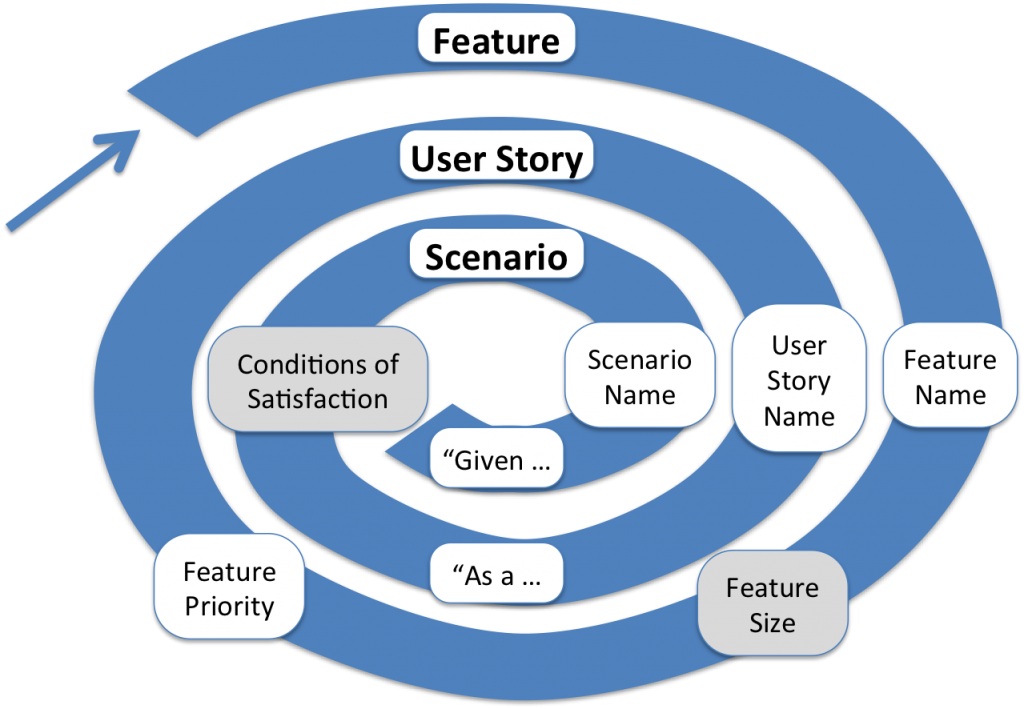Epics aren’t very good for driving the development team because Epics lack sufficient detail and will take too long to complete anyway. But Epics are, like their smaller relatives the user story, great as a place holder for a conversation.
Continue reading
Tag Archives: agile
User Story Format Should Not Be a Straight Jacket
I use the formal “As <user role> I want to <action> so that <goal>” format when it helps. The main value of the format is it puts the focus on the users rather than on technology components. So if the user story is about user facing functionality then I will usually use the formal format as a back up to the shorter name of the user story.
Continue reading
4 Objectives for an Automated Test Strategy
I recently explained to my team the objectives our automated test strategy had to fulfil:
- Provides “living” requirements documentation
- Results in a comprehensive regression test suite
- Ensures high functional coverage
- Runs fast for developers
When Meeting Madness Strikes
Some people and some organisations like meetings. If you drop Agile with its Agile Heartbeat into the mix then you might find that meeting madness strikes.
I’m a Kiwi living in the UK and I’ve noticed the British will form a queue if given the barest of excuses. Similarly, in some organisations, the people will call a meeting at the drop of a hat. People in coordination roles (e.g. project manager, discipline lead) seem particularly prone to this.
Don’t.
Continue reading
Agile Requirements Snail: Feature to User Story to Scenario
The Iterative Incremental approach inherent in Agile applies to delivered functionality but also to the requirements elicitation part of the process.
I like to refine requirements over time. Start high level, just enough to remind us to have a conversation, then fill in the detail just as we need it. What starts as a simple name of an Epic Feature will turn into multiple User Stories each with several Scenarios. But you don’t need all of that at the start.
The iterative nature of requirements definition is suggestive of a spiral process – what my daughter would call a “snail”:
“Small” is an Estimate
One of the ironies of the discussion on no-estimates is that the no-estimate proponents do in fact estimate. In a small way.
Continue reading
Agile Programme Roles and Responsibilities
To go with my typical programme organisation I thought I’d describe the roles and responsibilities I expect on an Agile programme. Remember I’m interested in software delivery so I’m talking about programmes that have software development at the core. Non-software programmes would have a different mix of roles.
Some roles in an programme correspond to the roles in an project. The scale of responsibility is larger and emphasis on coordination greater but the nature of the roles is broadly similar. The Agile Programme Manager, Programme Product Owner and Technical Architect roles fit this mould, corresponding to Agile Project Manager, Product Owner and Technical Lead.
In addition a programme needs some roles that don’t appear at all in a project, in particular Programme Director and Business Change Manager. Again these roles are a result of the wider remit and increased communication necessary in a programme but also because of the focus on organisational transformation.
Continue reading
What do I do when There is More Than One Product Owner
The product owner defines what the development team is meant to build and the order in which it is built. What should you do when the Product Owner responsibilities lie with more than one person?
The short answer, that works in simple situations, is get the business to pick one. However things are not always so simple and there are situations where you will need more than product owner. I’ll outline a few scenarios, both good and bad, which for the purposes of this post I’ll characterise as Many Kings, Pretender to the Throne, and finally Chief and Indians.
Continue reading
Estimate To Inform Investment Decisions
Some people think estimating is “crystal ball gazing” (@agilemanager, 2 Nov 2012) leading to “bad decisions” (@WoodyZuill, 2 Dec 2012). I’m not one of them.
I don’t always estimate. Nor do I necessarily estimate everything. But I find estimating helpful when considering investment proposals. This is true whether picking the next user story or commissioning an entire project.
Admittedly estimating is not an exact science so I think George Dinwiddie (@gdinwiddie, 27 Feb 2013) summed it up nicely when he tweeted that “estimates turn the unknown into the unsure, based on someone else’s expertise”.
I believe that even estimates with caveats help the business make better investment decisions.
Continue reading
The Scrum of Scrums is not Agile Programme Management
Today I bumped into an article Bryan Zarnett wrote for the Scrum Alliance. I read the article mainly because the title caught my eye in Google – Running the Scrum of Scrums: Agile Program Management.
This leapt out at me because of the claim that the Scrum of Scrums is the same as Agile Programme Management. It isn’t.
Continue reading
